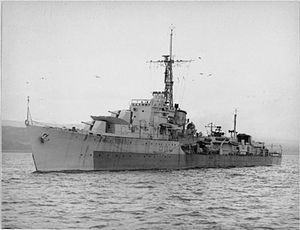HMS Zebra (R81)

| |
| History | |
|---|---|
| Name | HMS Zebra |
| Namesake | zebra |
| Ordered | 12 February 1942 |
| Builder | William Denny & Brothers, Dumbarton |
| Laid down | 14 May 1942 |
| Launched | 18 March 1944 |
| Commissioned | 13 October 1944 |
| Identification | Pennant number R81 |
| Fate | Arrived in Newport for breaking up 12 February 1959 |
| General characteristics | |
| Class and type | Z-class destroyer |
| Displacement | 1,710 tons |
| Length | 362 ft 9 in (110.57 m) |
| Beam | 35 ft 8 in (10.87 m) |
| Draught | 10 ft (3.0 m) |
| Propulsion | Twin steam turbines |
| Speed | 37 knots (69 km/h; 43 mph) maximum |
| Complement | 185 |
| Armament |
|
HMS Zebra was a Z-class destroyer. She was to have been named HMS Wakeful but was renamed in January 1943 before launching. The destroyer was launched on 18 March 1944 at William Denny & Brothers shipyard in Dumbarton, Scotland and commissioned on 13 October 1944. She was 'adopted' by the civil community of Urmston, then in the county of Lancashire.
Second World War[]
After a period of working up with ships of the Home Fleet at Scapa Flow Zebra joined the 2nd Destroyer Flotilla, Home Fleet for screening duty and patrol on the North Western Approaches. She escorted a number of Arctic convoys, and other operations in the North Sea and off the coast of Scandinavia. As the war reached its end Zebra was deployed with the Home Fleet to support operations to re-occupy countries previously under German occupation, and this included guardship duties.
Postwar[]
After the end of the war Zebra joined the 4th Destroyer Flotilla in which she served until 1947. The vessel was then paid-off and was reduced to reserve status in the Plymouth Reserve Fleet. During 1952 she was with the Harwich Reserve Fleet and returned to Plymouth a year later.[1]
Decommissioning and disposal[]
The ship was nominated for conversion to an anti-submarine frigate and her main armament was to be removed. However, in 1955 this work was cancelled and the ship was placed on the Sale List. There were plans to transfer her to West Germany, but after inspection by West German officials the proposal was rejected due to her poor condition and she was sold to BISCO in 1958 for breaking-up at Newport, Monmouth by Cashmore. On 12 February 1959 she arrived in tow at the breakers yard.
References[]
- ^ Critchley, Mike (1982). British Warships Since 1945: Part 3: Destroyers. Liskeard, UK: Maritime Books. p. 84. ISBN 0-9506323-9-2.
Publications[]
- Colledge, J. J.; Warlow, Ben (2006) [1969]. Ships of the Royal Navy: The Complete Record of all Fighting Ships of the Royal Navy (Rev. ed.). London: Chatham Publishing. ISBN 978-1-86176-281-8.
- Raven, Alan; Roberts, John (1978). War Built Destroyers O to Z Classes. London: Bivouac Books. ISBN 0-85680-010-4.
- Whitley, M. J. (1988). Destroyers of World War 2. Annapolis, Maryland: Naval Institute Press. ISBN 0-87021-326-1.
External links[]
- W and Z-class destroyers
- Ships built on the River Clyde
- 1944 ships
- World War II destroyers of the United Kingdom
- Cold War destroyers of the United Kingdom